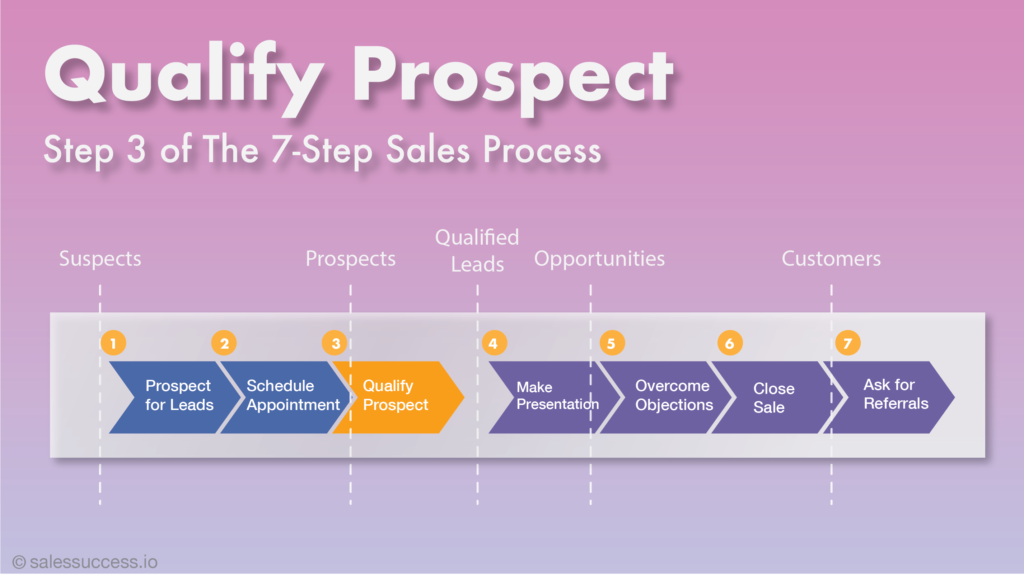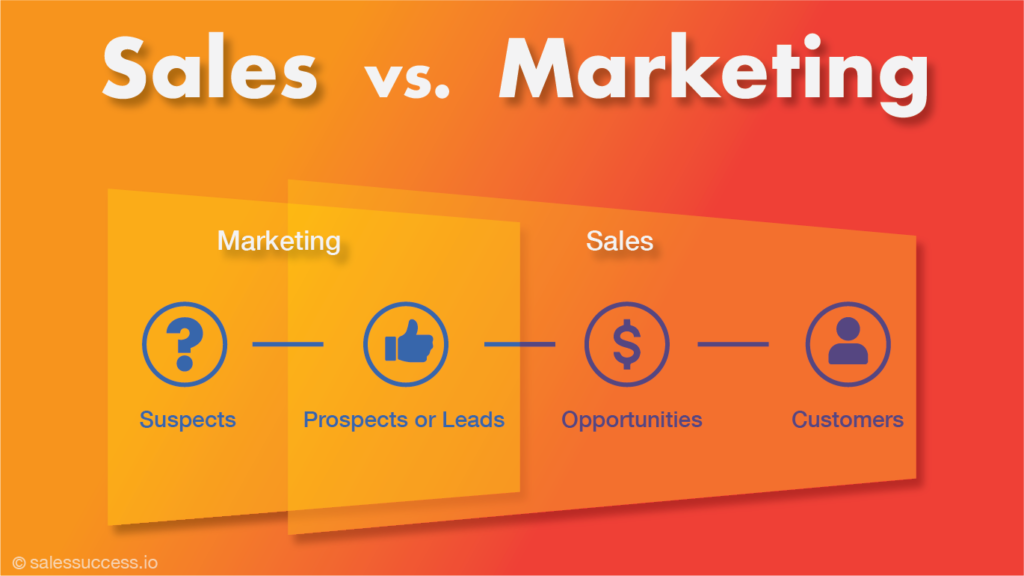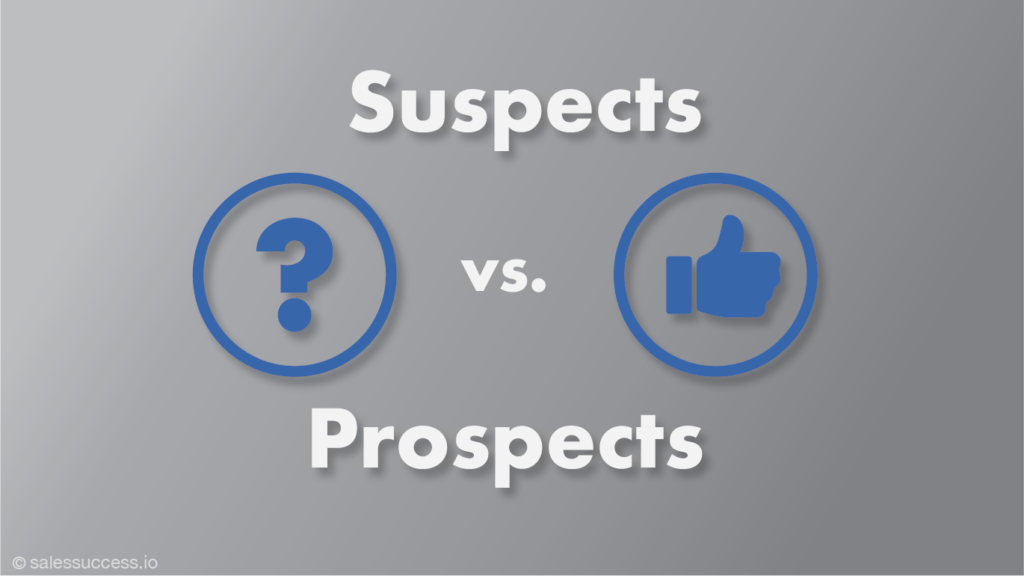- BDR vs. SR: Understanding the Sales Roles and Division of Labor
- Handling Objections: A Guide to Overcoming Customer Concerns
- Making Presentation: Tips for a Compelling and Engaging Delivery
- Qualifying Prospect: The Key to Sales Success
- Setting Appointment: Strategies and Tips for Successful Sales Calls
- Closing Sales: 44 Techniques and the Steps for a Successful Close
- Prospecting for Leads: Finding Your Next Customers
- Sales Process or Cycle: The 7 Steps to Sales Success
![]()
Introduction
This is the most important step in the end-to-end sales process. It is the third step after prospecting for leads and scheduling appointments with them.
You are talking to an interested prospect but you want to triage early on in your sales efforts and make sure that they do not waste your time if you move ahead in the process with them.
At the same time, you want to be sure that they too see themselves as a fit for your offering.
The sales prospect qualification step is also referred to as the discovery or needs assessment step as you seize the occasion to learn the exact needs and requirements of the prospect.
How to qualify a sales prospect?
The discussion will help you to position yourself as an expert and earn their confidence, and tailor the follow on product presentation or demo to their specific need.
Most importantly, the discussion will position your offering as the “pain killer.”
How well you qualify prospects and conduct discovery ultimately determines how high your win or close rate is. If you do them right, you will sail through the rest of the sales process.
You will just have to go through the motions thereafter.
Here are 7 keys to conducting an effective qualification and discovery call:
2. Probing questions and consultative selling
4. Call opening
5. Two-way conversation, storytelling, and active listening
7. Call closing
Capture Management
Considering the importance of the step to the overall sales success, the sales organization must determine who all should take part in the call.
Ideally, this is where capture managers, whose responsibility is to maximize the probability of winning, start to get involved.
In other settings, where business development reps or sales development reps pass on qualified leads to sales reps (SRs) or account executives, the latter should join the calls.
This would be the best way to eliminate perception gaps between the two team members in the quality of leads being passed on between them.
Additionally, sales managers; pre-sales reps, sales engineers, or product specialists; subject matter experts; product managers, etc. should be brought into this all too important call.
Probing Questions and Consultative Selling
You will ask probing and provocative questions on the call that will get the prospect thinking, talking, and opening up.
You are essentially guiding the prospect in a consultative manner to identify and reveal their challenges and motivations.
BANT
Your line of questioning should help you uncover answers to these prospect-qualifying questions:
B. Has the prospect set aside a sufficient budget for our offering?
A. Are we dealing with the decision-maker directly?
N. Do they have the need and can we fulfill it?
T. Will they buy within our timelines?
If and only if the answers to these questions are all a “yes”, then the prospect is qualified.
This popular qualification methodology called BANT developed by IBM helps you determine the four prospect-qualifying criteria: Budget, Authority, Need, and Timeline.
SPIN
Your line of questioning must help you understand and gather pertinent information about the buyer’s current situation and the context they are coming from.
The line of questioning must logically lead them to identify their problems and sense the urgency.
Your questions should help them explore the implications of those problems showing them why they need to be solved, and the value or payoff in choosing your offering.
This sequence of questions covering Situation, Problem, Implication, and Need-Payoff is the popular SPIN selling methodology by Neil Rackham.

Read the book here.
Call Planning
You have a limited time for the call to accomplish a lot. Preparation will be key to success.
You do your homework to orchestrate the call between the multiple participants from your side. You plan to ask the right and minimum set of questions.
You conduct your background research on the prospect to inform the situation questions you will ask as part of the SPIN selling methodology and make them relevant and company-specific.
Note that your prospect research should cover both the lead and the account.
Call Opening
To make the most of the call, right after the round of introductions of all participants on the call, you will layout the agenda from your side and remind the prospect of the agreed-upon time for the call.
You will also ask them for their expectations from the call and get their buy-in on the agenda.
You will agree on the rough time allocation for each agenda point and then steer the call and manage time skillfully.
Two-Way Conversation, Storytelling, and Active Listening
In addition to the opening, there are three key traits you will exhibit on the call.
The first is your questioning cannot come across as an interrogation. Instead, you steer a pleasant and naturally-flowing two-way dialog with the prospect. They should feel engaged.
The second is storytelling. One of the expectations your prospects will have from you is to share how similar companies in their verticals have faced similar challenges.
Elaborate for them on how your offering has helped those other companies overcome their challenges. Be prepared to narrate compelling case studies.
The third is to listen to them keenly. In fact, you should speak less and allow the prospect to speak for much of the call.
While they are speaking, acknowledge by nodding your head or uttering “uh huh” to indicate that you are listening. The more they talk, the more you will gain from the call.
Vision Setting
You will end your questioning with need-payoff questions of your SPIN selling technique and lead the prospect to conclude on their own how your offering will address their pain points.
Put differently, you will guide the prospect to define the “To Be” state.
At this point, you and the prospect both have a clear understanding of the prospect’s pain and the value of solving it for them.
It’s your turn next to lay it out for the prospect exactly how your offering will address each of their pain points and migrate them from the current “As Is” state to the future “To Be” state.
Call Closing
Assuming the prospect is qualified, you will close the call successfully by first seeking concurrence from the prospect that you have addressed all of their pain points.
You will then agree on the next steps with the prospect. Usually, a detailed product presentation or demo is the immediate next step.
You will make sure to bring other important stakeholders from the prospect’s side into the next steps. To this end, seek the prospect’s consent and help:
“Can we bring in the others also who will be involved in the buying decision to the presentation?”
Conclusion
In conclusion, qualifying your prospects is a crucial aspect of sales success. By identifying the right leads, you can save time, increase your chances of closing deals, and ultimately grow your business.
Remember to ask the right questions, listen carefully to your prospects’ answers, and use your judgement to determine whether they are a good fit for your product or service.
Subscribe to our Blog



